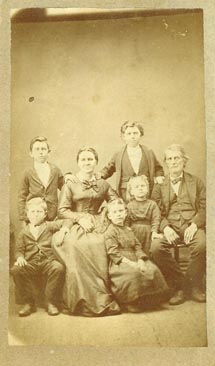Sign up for the Family Tree Newsletter Plus, you’ll receive our 10 Essential Genealogy Research Forms PDF as a special thank you!
Get Your Free Genealogy Forms
"*" indicates required fields

Until recently, Mike Duckwall was an addicted genealogist who didn’t own many photos or family papers—until he found another relative’s research and a big box of pictures in his uncle’s closet. “This box was like a treasure chest full of gold,” Mike says. It’s easy to identify with that feeling.
Duckwall’s lucky. Someone took time to label all the pictures except those in an album. This photo was in the back of the album—Duckwall thinks it’s a portrait of his great-great-great-grandfather Samuel Duckwall and his family, but wants me to weigh in with an opinion.
He knows Samuel Duckwall (1800 to 1869) married Mary Catherine St. Clair Eakins (born in 1816). They had three boys and four girls:
- Nancy Rebecca (1840 to 1843)
- Lewis Raper (born in 1843)
- John St. Clair (born in 1845)
- William Christie (born in 1848)
- Eliza F. (1851-1865)
- Susan (born in 1854)
- Jennie (born in 1857)
In the 1860 Census Samuel appears with his wife and all of their living children residing in Hillsboro, Ohio.
Duckwall doesn’t know when this picture was taken, and if this really is a photo of Samuel, Mary and their kids-three boys and two girls.
If this is Samuel Duckwall, the photo would have to have been taken prior to the birth of his last child, Jennie, in 1857. If it was taken in 1856, the family would be as follows: Samuel, 56; Mary, 40; Lewis, 13; John, 11; William, 8; Eliza, 5 and Susan, 2. This looks like a match until you consider the other evidence.
If the photo dates from 1857, it would be an ambrotype, daguerreotype or tintype. This is a paper image, called a cartes des visite—they weren’t introduced in the United States until 1858. It’s possible this is a copy of another type of image, but the photo dimensions don’t match commonly available sizes of daguerreotypes and ambrotypes.
The children’s ages add to the confusion. If this image was taken in 1858, where’s baby Jennie and why don’t the boys look like young teenagers?
The photographer—Kinkead’s Photographic Gallery, Hillsboro, Ohio, according to the imprint—appears in Diane Gagel’s book, Ohio Photographers: 1839-1900 (Carl Mautz, $35) as C.S. Kinkead, in business from 1875 to 1879.
The clothing is another consideration. The woman’s dress doesn’t have all the characteristics commonly found in the 1850s, such as a wide lace collar, undersleeves and hair worn over the ears—but she could be dressed conservatively for economic reasons. Wide bows like the one on her bodice appear beginning in the 1850s; however, I’m more comfortable with a late 1860s or early 1870s date because of her button-front bodice and small collar. For an overview of fashion in the 1840s through 1860, look at Joan L. Severa’s new book, My Likeness Taken: Daguerreian Portraits in America (Kent State University Press, $65)
So is this Samuel Duckwall and family? I’m not sure. Frankly, this photo is a mystery. Mike Duckwall sent me portraits of the children as adults but don’t look like the kids in this portrait.
Here, the oldest boy and his mother have identical facial features, as do the father and the older girl, which might help with the identification. <!–
Watch for props. –><!–
2000–>
ADVERTISEMENT

